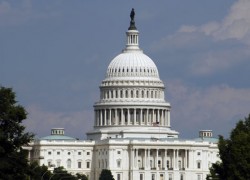
Worse, because of the Obama Administration’s decision to spread the cuts to a wider range of spending, the level of base spending in the CR will be higher than it should be, because some of the cuts are made not to bloated agency budgets but one-time emergency or disaster funding.
As a result, base discretionary spending will be $7 billion higher, making it more difficult to get the government on a path to a balanced budget. Nor does the CR adequately address sequestration’s serious impact on military readiness and defense capabilities.
Though the required sequester cuts total $85 billion, just $68 billion goes to discretionary spending; the remainder applies to mandatory spending. If the $68 billion had been applied solely to the $1.043 trillion of the ongoing CR appropriations, it would have reduced base discretionary spending to $975 billion. Total discretionary spending, including war funding, emergencies, and the like, would be $1,126 billion. The last time spending was at lower levels than this was 2007, just before the financial meltdown.
The CR, however, applies the sequester to other spending as well. Specifically, spending for overseas contingency operations (OCO), Hurricane Sandy relief (emergency spending), other disaster relief, and “program integrity” activities (to address waste, fraud, and abuse)—which total $153 billion—are subject to $9 billion of sequestration.
These things, by their very nature, are temporary spending that does not occur every year. OCO itself is on a steep downward path. So now the sequester will also cut one-time spending rather than solely cutting bloated agency budgets. This may sound good on the face of it, but by applying the sequester cuts to this broader mix of spending, as the CR does, next year’s budget will actually be $7 billion higher than it should be. Budgets for ongoing agency spending in the CR would total $982 billion, not $975 billion.
Ironically, the OCO and other one-time spending were exempt from spending caps in the Budget Control Act (BCA), and Congress and the President exploited these loopholes to get the higher spending they desired. Now, because this funding also absorbs the sequestration cuts, they allow higher spending in agency’s ongoing budgets—called the “base,” in budget-speak.
The decision to spread sequestration this way was the Administration’s. According to the legislation governing sequestration, the Office of Management and Budget determines how the sequester is applied.
Would this deliver the catastrophic cuts President Obama predicted? Look at the numbers. Over the past 10 years, discretionary spending has grown more than 40 percent—after adjusting for inflation.
Over that same period, some spending areas have had astonishing increases:
- Energy: 1,700 percent;
- K-12 education: 145 percent;
- Food stamps and other nutrition programs: 137 percent.
As noted above, the CR does nothing substantive to mitigate the harmful effects of sequestration on military readiness, effectively locking in the hollowing of the military that began under President Obama. As Heritage’s Jim Carafano notes, “it’s like a bandaid when surgery is required.”
So the CR doesn’t do an adequate job of reprogramming sequestration, and it doesn’t roll back agency spending further. This was also a lost opportunity to get rid of autopilot budgeting, cut spending in a rational way, and return to real governing. Instead, it increases structural spending and only contributes to the bigger challenge of reining in spending and balancing the budget. Meanwhile, the impact of sequestration on the budget keeps shrinking.
Source material can be found at this site.









